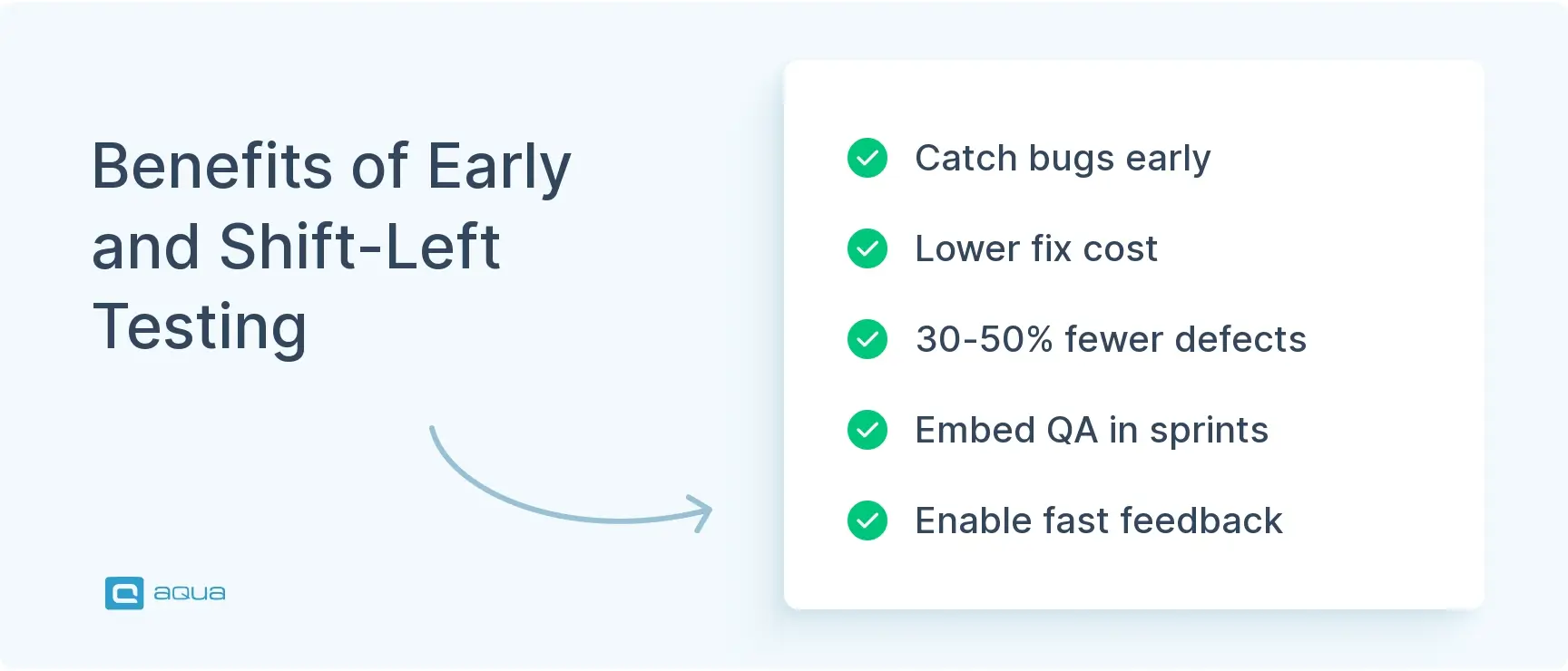Key Takeaways
- Effective test management requires clear objectives that align with business priorities and technical requirements using the SMART framework for specific, measurable outcomes.
- Comprehensive test planning begins with risk assessment to prioritize critical areas, covering test scope, techniques, environment needs, timelines, and acceptance criteria.
- Well-designed test cases must include both positive and negative scenarios with clear pass/fail criteria, each linking directly to specific requirements for traceability.
- The “shift-left” testing approach catches defects early when they’re up to 100 times less expensive to fix, with teams implementing early testing seeing 30-50% fewer production defects.
- Test management tools centralize testing artifacts, improve efficiency through test case reuse, and provide real-time dashboards showing execution status and quality metrics.
Testing without proper management is like driving without a map—you’ll burn resources but might never reach your destination. Want to transform testing from a bottleneck into your strategic advantage? Discover the complete framework for balancing thoroughness with efficiency below 👇
1. Understanding Requirements and Defining Clear Objectives
Starting testing without clear objectives is like taking a road trip without knowing where you’re going. You burn time and resources but never actually arrive anywhere useful. Your test objectives need to align with business priorities and technical requirements so your quality efforts support what actually matters.
Understanding requirements is the foundation of effective test management. A comprehensive Software Requirement Specification (SRS) document acts as your testing blueprint. It details what the software should do and how it should perform. This helps testers identify what needs validation and creates a shared reference point for everyone. Without this clarity, testers focus on the wrong areas or miss critical functionality completely.
- Specific: Detail exactly what aspects of the software will be tested
- Measurable: Include quantifiable criteria for success
- Achievable: Set realistic goals given your resources and time constraints
- Relevant: Align with business priorities and actual user needs
- Time-bound: Establish clear deadlines for completion
Clear objectives prevent wasted effort. They tell your team what success looks like and keep everyone focused on delivering quality where it counts most.
2. Comprehensive Test Planning and Strategy Development
With clear objectives in place, you need a roadmap to achieve them. That’s where comprehensive test planning comes in.
A well-crafted test plan outlines the what, when, how, and who of your testing efforts. It brings clarity to the entire team. But creating an effective test plan isn’t about filling out a template. It requires strategic thinking about how to allocate limited resources for maximum impact.
Start with a risk assessment. Identify which areas of your application carry the highest potential for critical defects or user impact. Payment processing in an e-commerce application represents higher risk than a contact form. This risk-based approach helps you prioritize where to concentrate testing efforts instead of applying the same scrutiny everywhere.
Your test strategy should include:
- Scope definition: What will and won’t be tested
- Testing types and techniques: The approaches you’ll use
- Environment requirements: Where tests will run and what test data you need
- Resource allocation: Who does what and when
- Timeline: Milestones and dependencies mapped out
- Risk mitigation: Plans for handling potential issues
- Acceptance criteria: What needs to pass before moving to production
A visual representation like a flowchart helps team members understand how different components fit together. This creates shared understanding and makes it easier for everyone to follow the testing roadmap throughout the project.
With your strategy mapped out, the next step is designing test cases that actually cover what matters.
3. Test Case Design for Comprehensive Coverage
Your strategy tells you what to test. Now you need to design test cases that actually verify your software works as intended.
Well-designed test cases are the building blocks of effective quality assurance. They transform abstract requirements into specific, executable validation steps. The best test case design techniques find the sweet spot between thoroughness and efficiency, covering all critical paths without unnecessary redundancy.
Test cases should cover positive scenarios (features work as expected), negative scenarios (appropriate handling of invalid inputs or errors), and boundary conditions (edge cases and limits). Each test case needs to be specific, repeatable, and include clear pass/fail criteria. No ambiguity about results.
A good test case structure typically includes:
- Test ID: Unique identifier for tracking and reference
- Title: Clear, descriptive name summarizing what’s being tested
- Priority: Importance level (high, medium, low) for execution planning
- Preconditions: Requirements that must be met before executing the test
- Test Data: Specific inputs needed to execute the test
- Test Steps: Numbered, detailed instructions for execution
- Expected Result: What should happen when steps are executed correctly
- Actual Result: What actually happened during execution (filled during testing)
- Status: Pass/fail/blocked outcome (filled during testing)
- Notes: Any additional observations or relevant information
An example:
Test ID: TC001
Title: Verify user login with valid credentials
Priority: High
Preconditions: User account exists in system
Test Data: Username = “testuser”,
Password = “validpass123”
Steps:
Navigate to login page
Enter username in username field
Enter password in password field
Click login button
Expected Result: User successfully logs in and is redirected to dashboard
Actual Result: [To be filled during execution]
Status: [To be filled during execution]
Notes: [Any observations or additional information]
This approach ensures anyone on the team can understand and execute the test case. This matters when different testers run the same cases during various test cycles. Each test case should link directly back to a specific requirement or user story to maintain traceability throughout development.
With solid test cases ready, timing becomes the next critical factor in your testing success.
Designing comprehensive test cases manually is time-consuming and leaves gaps. An AI test management solution like aqua cloud changes this completely. Its AI Copilot generates test cases automatically from your requirements, cutting manual design time by up to 98% while covering positive, negative, and boundary scenarios. It also generates test data instantly, eliminating another major bottleneck. The unified repository maintains perfect traceability from requirements to test cases to defects, showing exactly what has coverage and what doesn’t. Reusable test components and nested test cases let you build modular test suites that scale with your application. Real-time dashboards show execution status, pass/fail rates, and coverage metrics. Integration with CI/CD pipelines, Jira, Azure DevOps, and automation frameworks means it fits your existing toolchain seamlessly, turning test case design from a manual burden into an automated advantage.
Transform your test management approach with AI-powered efficiency and complete traceability
4. Early Testing and Utilizing Modern Methodologies
Timing in testing matters more than most teams realize. Waiting until the end to test is expensive and risky.
The shift-left approach has changed how teams think about quality assurance. Instead of treating testing as the final checkpoint before release, modern teams integrate testing throughout development, starting from the earliest stages. This fundamental shift delivers enormous benefits in both quality and efficiency.
When testing begins early, defects get caught when they’re still cheap to fix. Bugs found in production can cost up to 100 times more to fix than those found during early design phases. This dramatic cost difference comes from the compounding effect of defects. Early bugs often create dependencies that lead to more bugs, requiring extensive rework if discovered late.
Agile and DevOps methodologies embrace this early testing mindset:
- Integrate testers into development teams from day one
- Include test planning during sprint planning sessions
- Implement test-driven development (TDD) where tests are written before code
- Automate unit tests that run with every code commit
- Conduct continuous integration testing to catch integration issues early

The correlation between early testing and defect reduction is striking. Teams that implement shift-left practices typically see 30-50% fewer defects making it to production compared to traditional waterfall approaches. This translates directly to higher quality software and more predictable delivery timelines.
Early testing sets the foundation, but you also need variety in your testing approach to catch everything.
5. Combining Different Testing Types
A comprehensive testing strategy needs variety to ensure complete coverage. Relying on one testing type leaves your application vulnerable to certain categories of defects.
Functional testing verifies that your application’s features work as expected from a user perspective. This includes unit testing (testing individual components in isolation), integration testing (verifying components work together), and end-to-end testing (validating complete user journeys). While functional testing ensures the software does what it’s supposed to do, non-functional testing confirms it does it well.
Non-functional testing addresses crucial aspects like:
- Performance testing: How does the system handle load and stress?
- Security testing: Is user data protected from unauthorized access?
- Usability testing: Can users navigate the interface intuitively?
- Compatibility testing: Does the application work across browsers and devices?
- Accessibility testing: Can all users, including those with disabilities, use the software?
The key to success is integrating these different test management techniques into a cohesive strategy. Security testing shouldn’t be a one-time activity but should be embedded into the development process alongside functional testing. Similarly, performance considerations should inform development decisions from the beginning rather than becoming an afterthought.
A balanced testing approach might include running unit and integration tests with every code commit, conducting security scans weekly, and performing comprehensive end-to-end tests before each release. This layered approach catches different types of issues at various stages, creating multiple safety nets for your quality assurance efforts.
Testing types matter, but how you communicate what you find matters just as much.
6. Effective Bug Reporting and Communication
Finding bugs matters. But how you communicate them matters just as much.
Clear, detailed bug reports are the difference between efficient development cycles and wasted time. When defects are poorly documented, developers spend hours trying to reproduce issues instead of fixing them. A well-structured bug report bridges the communication gap between those who find bugs and those who fix them.
The most effective bug reports include precise reproduction steps, environmental details, and visual evidence like screenshots or videos. They clearly distinguish between expected and actual behavior, helping developers quickly understand what went wrong. Proper severity and priority classifications help teams focus on the most critical issues first.
A standard bug report should include:
- Concise, descriptive title: Summarizes the issue clearly
- Environment details: Browser/OS/device, app version, user account
- Reproduction steps: Numbered, specific instructions
- Expected vs. actual results: What should happen and what actually happens
- Visual evidence: Screenshots, videos, or log files
- Severity classification: Critical, major, minor, cosmetic
- Priority level: Urgent, high, medium, low
- Affected component: Which feature or area has the issue
Regular bug triage meetings bring testers, developers, and product owners together to review new defects, assign priorities, and make fix or defer decisions. This collaborative approach ensures everyone shares a common understanding of quality issues and aligns on resolution plans.
Communication extends beyond formal bug reports. Create a culture where quality is everyone’s responsibility. This encourages open dialogue about potential issues and strengthens your entire quality ecosystem.
Quality isn’t just for testers. The best testing strategies leverage diverse perspectives across your organization.
7. Involving Non-Testers in the Testing Process
Quality assurance works best when it’s not just for professional testers. The most effective testing strategies leverage diverse perspectives from across the organization, creating a whole-team approach to quality.
Developers bring deep technical knowledge. When they participate in testing beyond their own unit tests, they gain firsthand experience of how their code performs in real scenarios. This direct feedback loop leads to more robust code and fewer defects in future work. Having developers join exploratory testing sessions often reveals integration issues that automated tests miss.
Business analysts and product owners contribute domain expertise essential for validating business logic. They understand the why behind features and can verify that implementations truly meet business objectives, not just technical specifications. Their involvement in acceptance testing helps ensure the software delivers real value to users.
Some organizations create citizen tester programs that engage non-technical employees or actual customers in beta testing. These participants often uncover usability issues or workflow gaps that internal teams overlook due to familiarity with the system. One company reported their citizen tester program identified 37% more usability issues than their professional QA team alone.
To successfully involve non-testers:
- Provide clear guidelines and templates for feedback
- Create simplified test scenarios focused on their areas of expertise
- Schedule dedicated testing sessions with specific goals
- Recognize and reward valuable contributions to quality
- Use their feedback to improve both the product and the testing process
With diverse perspectives contributing to testing, the next step is determining where automation adds the most value.
You can’t automate everything. And without a test management tool how do you link your tests to requirements, stories, and bugs?
8. Strategic Use of Automation Testing
Automation has evolved from nice-to-have to essential. But successful automation isn’t about automating everything. It’s about making strategic choices about what to automate and when.
Automation delivers the most value for repetitive, predictable test scenarios that need frequent execution. Regression tests are prime candidates since they verify existing functionality remains intact when new features are added. Smoke tests that validate basic application functionality and data-driven tests that need execution with multiple data sets also benefit from automation.
Not everything should be automated. Tests that run infrequently, require complex human judgment, or involve rapidly changing interfaces often deliver better ROI when performed manually. The key is finding the right balance based on your specific project needs and constraints.
When building your automation strategy, consider:
- Prioritize stable features with high business value
- Start with API/service layer tests for faster, more reliable execution
- Use a pyramid approach with more unit tests than UI tests
- Choose maintainable frameworks that allow for easy scaling
- Plan for test data management from the beginning
Recent advances in AI-powered testing tools have expanded automation possibilities. Self-healing test scripts automatically adjust when UI elements change, reducing maintenance overhead. AI also helps generate test cases, analyze result patterns, and prioritize testing efforts based on risk analysis.
Automation should complement manual testing, not replace it entirely. The most effective testing strategies combine automated checks for known functionality with exploratory human testing to uncover unexpected issues that automated tests might miss.
Automation helps execute tests efficiently, but managing everything requires the right platform.
9. Utilising Test Management Tools
As testing efforts scale beyond a handful of test cases, managing the process manually becomes increasingly difficult. Dedicated test management tools provide the structure and visibility needed to coordinate complex testing activities across multiple team members and test cycles.
A robust test management platform serves as the central repository for all testing artifacts: requirements, test cases, execution results, and defects. This centralization creates a single source of truth that helps teams track progress, identify coverage gaps, and make informed decisions about release readiness.
Key features to look for include:
- Test case organization with versioning and reusability
- Requirements traceability to ensure complete coverage
- Execution planning and scheduling capabilities
- Defect tracking or integration with bug tracking systems
- Automated test integration for running and reporting results
- Customizable dashboards and reporting
- Collaboration features for distributed teams
- CI/CD integration with other development tools
The right test management tool dramatically improves efficiency through test case reuse, automated reporting, and streamlined workflows. It also enhances visibility by providing real-time insights into testing progress and quality metrics. Dashboards showing test execution status, pass/fail rates, and coverage percentages help stakeholders quickly assess quality health.
When choosing a test management system, consider your team’s specific needs, existing toolchain, and growth trajectory. The goal isn’t just to digitize your current process but to enable process improvements that wouldn’t be possible with manual management.
With the right tools in place, measurement becomes the final piece that drives continuous improvement.
10. Continuous Measurement and Improvement
What gets measured gets improved. Without concrete metrics, teams can’t objectively evaluate their testing effectiveness or identify areas for improvement. A thoughtful measurement strategy provides the data needed to make informed decisions about process changes, tool investments, and quality initiatives.
Effective quality metrics balance process measures (how testing is conducted) with outcome measures (what results are achieved). Key performance indicators to consider:
| Metric | Description | Target |
|---|---|---|
| Defect Detection Percentage | Percentage of defects found during testing vs. total defects | >85% |
| Defect Leakage | Percentage of defects that escape to production | <5% |
| Test Coverage | Percentage of requirements covered by tests | >95% |
| Test Case Effectiveness | Number of defects found per test case | Increasing trend |
| Automation Coverage | Percentage of test cases automated | Depends on project |
| Mean Time to Detect | Average time to detect defects | Decreasing trend |
| Test Execution Velocity | Number of test cases executed per time period | Increasing trend |
Track these metrics over time to identify trends and patterns. If defect leakage is increasing, it might indicate gaps in test coverage or execution. If test execution velocity is decreasing despite automation efforts, the team might need to address technical debt in the test suite.
Continuous improvement comes from regularly reviewing these metrics and implementing targeted changes. This might include adjusting testing processes, investing in new tools or training, or reallocating resources to high-risk areas. The key is creating a feedback loop where measurement leads to action, which produces improved measurements in the next cycle.
Many successful teams establish retrospective meetings specifically focused on testing. These sessions review quality metrics, discuss what’s working and what’s not, and identify specific improvements to implement in upcoming work. This systematic approach gradually raises the bar for quality while making testing more efficient.
These ten best practices for test management work together to create a comprehensive approach to quality assurance.
Conclusion
Effective test management is about implementing practical strategies that balance thoroughness with efficiency. The ten test management best practices we’ve covered give you a framework for creating a robust testing process that adapts to changing project needs while maintaining high quality. Start with clear objectives. Build comprehensive test plans. Design test cases that cover what matters. Test early and often. Combine different testing types. Communicate bugs effectively. Involve the whole team. Automate strategically. Use the right tools. Measure and improve continuously. These practices will transform your testing from a bottleneck into a strategic advantage that delivers better software, happier users, and more predictable project outcomes. Your testing doesn’t have to be chaotic. With these practices, it becomes the foundation for shipping quality software consistently.
Implementing these best practices individually can be challenging, but with the right test management platform, you can address all ten simultaneously. aqua cloud provides the comprehensive infrastructure needed to elevate your testing strategy, from requirements traceability to AI-powered test case generation to customizable dashboards that visualize your quality metrics in real-time. By centralizing all testing assets in a single repository with powerful automation capabilities, teams typically reduce manual effort by up to 98% while achieving near-perfect requirement coverage. The platform’s integrated defect management, coupled with Jira integration, streamlines the bug reporting and resolution workflow described in practice #6. And with custom dashboards and KPI alerts, you’ll have the continuous measurement framework needed for ongoing improvement. Rather than piecing together multiple tools or struggling with spreadsheets, aqua cloud delivers a unified approach to test management that transforms quality assurance from a bottleneck into your competitive advantage.
Save 98% of your testing time while achieving complete test coverage and traceability


















